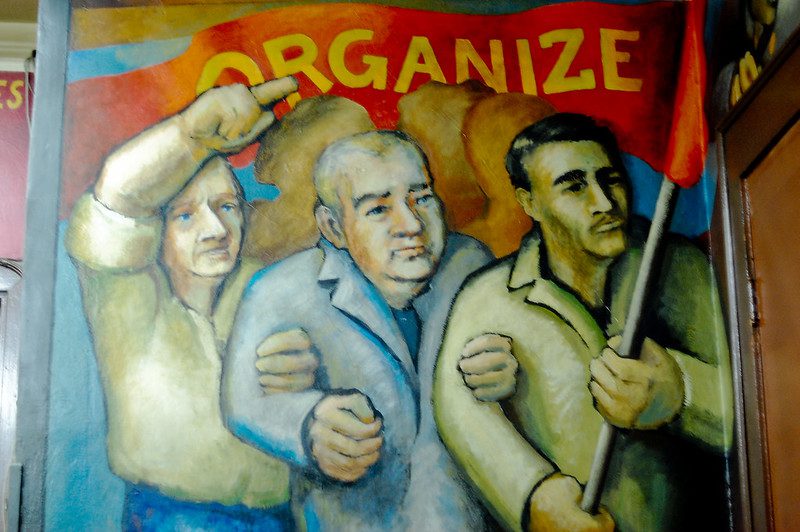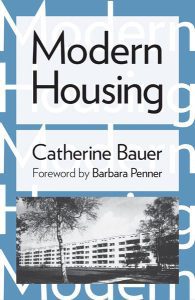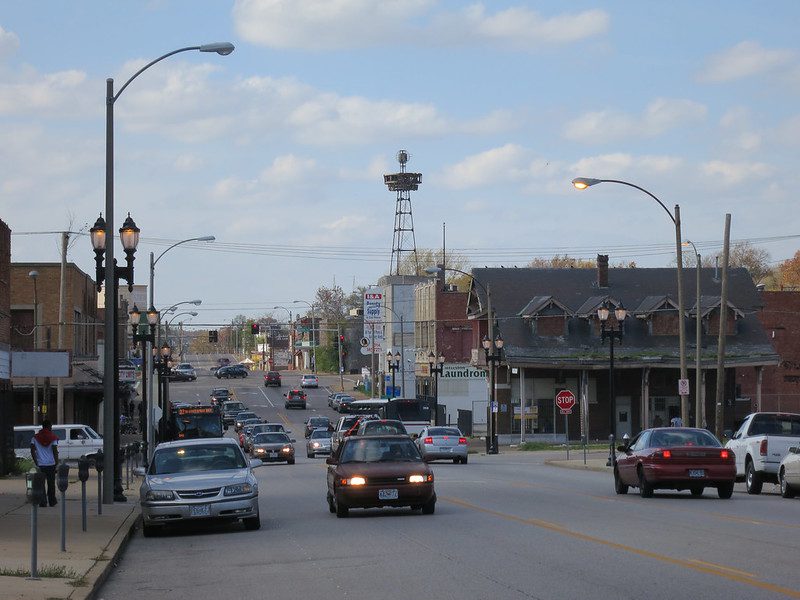
Detail of mural depicting history of United Electrical Workers union, Chicago, painted in 1974. Photo by Flickr user Eric Allix Rogers, CC BY-NC-ND 2.0
The time is ripe to forge a new coalition of labor unions and housing justice activists at the national, state, and local levels, as has been done in Los Angeles to pass Measure ULA.
Over the past century, federal investment in affordable housing was strongest when progressive housing activists were part of a broad movement for social reform that linked housing to other issues. In particular, they joined forces with the labor movement. Their bold demands were matched by political skills. Not only did they think big, they also organized well. They built movements and coalitions. In particular, “housers” hitched their ideas to the one vehicle that could effectively mobilize the political power needed to enact progressive housing legislation: organized labor.
Starting in the early 1900s, unions sponsored the first social housing projects, in New York, Philadelphia, and other cities. This was a bold effort to provide alternatives to the slum housing available to most working families at the time. They also fostered educational and political opportunities for union members, to create a sense of solidarity and community.
During the Depression, the labor movement played a key role in pushing the New Deal to invest in housing in order to create jobs and improve workers’ living conditions. In 1934, the AFL created the Labor Housing Conference, a lobbying group to push for government-sponsored and union-sponsored social housing. They hired Catherine Bauer as the executive director. That year she wrote a book, “Modern Housing,” that described the social housing achievements she’d seen in her visits to Europe and the union-sponsored housing she’d seen in the United States.

Reprinted in 2020.
Bauer and the Labor Housing Conference became the leading advocates for well-designed, mixed-income, noncommercial, government-subsidized housing projects, sponsored by unions, other nonprofit organizations, and government agencies. The first wave of public housing projects was modeled on the unions’ own social housing successes.
Those early public housing projects were a big success, with long waiting lists to get in. But eventually, the advocates for government-subsidized social housing were outmaneuvered by the real estate industry, led by the National Association of Real Estate Boards. The industry called this housing “socialism.” It successfully lobbied to limit public housing to the very poor, so that working class and middle class families would have to rely on the private housing market.
After World War II, the real estate lobby persuaded Congress to cut the budget for public housing. As a result, few new projects were built and the ones that were already built were deprived of the operating subsidies they needed to maintain the buildings. Many of the amenities and social services were canceled. Public housing got an unfair reputation as ugly and unmanageable warehouses for the extremely poor. Through the 1970s, the labor movement remained influential players in pushing for more federal funds for housing vouchers, subsidized housing developments, and funding to repair public housing.
But as unions lost membership and clout, the labor movement put its “social” agenda (such as housing) on the back burner, trying simply to maintain membership and political influence.
Despite a significant decline in union membership since the 1970s—from about 25 percent of all workers to about 10 percent today—organized labor remains the largest and most influential part of the nation’s progressive movement.
Part of organized labor’s recent renewal has been a growing recognition that unions tend to do better in gaining support and winning workplace elections—and do better at electing pro-worker political candidates—when they address the social and community concerns of their potential members (such as health care, childcare, and housing) as well as their workplace problems.
In the past decade—particularly in the past few years—there’s been a resurgence of labor organizing. A new cohort of labor activists at both the national and local levels is now seeking to rekindle the “movement” spirit of activist unionism, in part by focusing on the low-wage service and manufacturing sectors, which are made up disproportionately of women, people of color, and immigrants.
More recent union drives at Starbucks, Amazon, REI, and other visible corporations, and successful strikes at John Deere and Kellogg, among other companies, have made headlines. A recent Gallup Poll found that 71 percent of Americans now support unions—the highest since 1965.
Widening inequality accounts for much of this newfound activism, but so does a new attitude about work—exacerbated by the COVID pandemic—among younger workers, particularly workers of color. In fact, workers of color now account for 38 percent of the nation’s 13 million union members. Black workers are the most likely to be represented by unions: 13.6 percent are covered by a collective bargaining agreement, compared with 12.3 percent of white workers, 11 percent of Hispanic workers, and 10.3 percent of AAPI workers.
Labor unions have increasingly embraced issues of environmental justice, LGBTQ equality, and women’s rights.
Today, housing policy for working class Americans lacks a coherent and well-organized political constituency. Federal housing policy today ignores most of the poor and offers little for the near-poor and the fragile lower middle class. In fact, the federal government spends more to help well-off homeowners than low-income renters. The biggest federal housing subsidy today is the mortgage interest deduction, a tax break that goes disproportionately to homeowners with incomes over $200,000. In addition, when homeowners sell their homes, the capital gains on the sales are excluded from federal taxes. This costs the federal government another $40 billion a year, which disproportionately benefits the wealthiest homeowners.
Organized labor clearly has a stake in progressive national housing policy. Working families need help paying the rent or buying a home. Likewise, housing and community activists have a stake in a stronger labor movement. They have many overlapping members. Renters benefit when workers have better pay, benefits, and job security. A labor-tenant political coalition could have major consequences for both groups. Tenants could be the sleeping giant in American politics, particularly in cities and in suburbs with many apartments, and where rents are rising faster than wages.
Investing resources in organizing renters can have significant payoffs for advancing social justice and electing progressive candidates. Historically, tenants vote at much lower rates than homeowners, but that gap has been shrinking. An analysis by a real estate research group found that “if voter turnout among renters had matched that of homeowners in the 2016 elections, Hilary [sic] Clinton would have beat former President Trump handily, and Democrats would have likely won additional seats in both the House and Senate.”
Increasing turnout among renters could play a decisive role in battleground races for mayor, state legislature, governor, Congress, and even president. Another study noted, “A coalition of renters could swing elections for politicians offering a vision of inclusive economic hope for the millions of diverse renters struggling in today’s economy.”
Catherine Bauer, a leader of the Labor Housing Conference, wrote in 1934 that “there would never be a real housing movement until workers and consumers organized an effective demand: that housing is a major political issue or it is nothing.”
As last year’s victory in Los Angeles demonstrates, the same is true today.





Comments